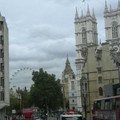的点评
A small but elegant castle, 大垣城, Ōgaki-jō.
Ogaki Castle的点评
点评:We took the JR Tokaido Main Line here from NGO. There is a small tourist centre in the JR station when one can ask for direction but for us it was simpler - homework showed that it is about 20 mins walk up north direct.
A flatlands-style Japanese castle (like Hiroshima, Wakayama castles) so no upslope required. Badly damaged during WW2 it is another concrete reconstruction of a 16th century castle that we visited . Ogaki was the closest castle to the battlefield of Sekigahara and was involved heavily in the wars of the 16th century with Mitsunari Ishida of the Western army using it as his home base. It was designated as a national treasure in 1936. The museum inside the castle retells the story.
We also walked around the park surrounding and noted statue of Toda Ujikane, the first lord of Ogaki Castle imposingly sitting on a horse. One of the interesting point is a mark at the castle stones which mark the high-water level when torrential rain flooded the whole area.
About an hour is sufficient to explore the whole area. We then walked our way back to the sta.
A flatlands-style Japanese castle (like Hiroshima, Wakayama castles) so no upslope required. Badly damaged during WW2 it is another concrete reconstruction of a 16th century castle that we visited . Ogaki was the closest castle to the battlefield of Sekigahara and was involved heavily in the wars of the 16th century with Mitsunari Ishida of the Western army using it as his home base. It was designated as a national treasure in 1936. The museum inside the castle retells the story.
We also walked around the park surrounding and noted statue of Toda Ujikane, the first lord of Ogaki Castle imposingly sitting on a horse. One of the interesting point is a mark at the castle stones which mark the high-water level when torrential rain flooded the whole area.
About an hour is sufficient to explore the whole area. We then walked our way back to the sta.
翻译:我们从NGO乘坐JR东海道本线到这里。JR车站里有一个小型旅游中心,可以问路,但对我们来说更简单——家庭作业显示直接向北步行大约20分钟。
这是一座平地风格的日本城堡(类似于广岛、和歌山的城堡),所以不需要爬坡。它在二战期间遭到严重破坏,是我们参观的另一座16世纪城堡的混凝土重建。大垣是距离关原战场最近的城堡,在16世纪的战争中发挥了重要作用,西军的石田三成曾将其作为大本营。它在1936年被指定为国宝。城堡内的博物馆重现了这个故事。
我们还在周围的公园里散步,并注意到大垣城第一代城主户田氏兼的雕像,他威严地骑在马上。其中一个有趣的地方是城堡石头上的标记,它标记着暴雨淹没整个区域时的最高水位。
大约一个小时足以探索整个区域。然后我们步行返回车站。
这是一座平地风格的日本城堡(类似于广岛、和歌山的城堡),所以不需要爬坡。它在二战期间遭到严重破坏,是我们参观的另一座16世纪城堡的混凝土重建。大垣是距离关原战场最近的城堡,在16世纪的战争中发挥了重要作用,西军的石田三成曾将其作为大本营。它在1936年被指定为国宝。城堡内的博物馆重现了这个故事。
我们还在周围的公园里散步,并注意到大垣城第一代城主户田氏兼的雕像,他威严地骑在马上。其中一个有趣的地方是城堡石头上的标记,它标记着暴雨淹没整个区域时的最高水位。
大约一个小时足以探索整个区域。然后我们步行返回车站。
此点评仅代表旅行者个人的主观意见,并不代表TripAdvisor以及其合作方的意见。
关于我们
|新闻动态
|商务合作
|会员中心
|业主中心
|常见问题
|意见反馈
|联系我们
|营业执照
© 2025 Tripadvisor 版权所有。
使用条款 |隐私政策 |网站工作原理
部分照片由 VFM Leonardo 提供。
* Tripadvisor不是旅行社,也不是旅游预订服务代理商。我们提供免费、客观、公正的旅游资讯服务。 (显示更多)
TripAdvisor LLC 既不是预订代理商,也不是旅游运营商,不会向网站用户收取任何服务费。 按照规定,在 Tripadvisor 发布机票价格、游览和旅行套餐的合作伙伴(航空公司、旅行提供商及预订代理商),其标价须包含所有费用和附加费用。 例如, 机场出入境税费、消费税与其他服务费、手续费、杂费及附加费用。 当您向我们的某个合作伙伴进行预订时,请务必查阅他们的网站以了解当地行政部门要求的所有适用费用的具体情况。 除非另有说明,机票价格通常指的是一个人的价格(以人民币计)。
为方便起见,TripAdvisor LLC 根据从我们的预订合作伙伴获取的空房率计算每个酒店的均价。 对于游览和景点来说,所显示价格通常是每位成人的最低可用价格。 对于列出的任何旅行套餐或优惠,TripAdvisor LLC 无法保证任何特定的费率或价格。 此外,酒店均价每晚会更新,并以您的首选币种表示(使用现行汇率)。 由于这些已换算的价格是预估价格,因此,有关具体金额和币种请与预订网站进行核实。
此外,TripAdvisor LLC 无法保证我们网站上宣传的价格随时有效。 标价可能需要预订一定天数才能生效,或有不可用日期、使用条件或限制。
TripAdvisor公司对外部网站的内容一概不负责。优惠价格中不含税和其他费用。
ICP证:沪B2-20200433
沪ICP备20013175号
 沪公网安备31010502005427号
沪公网安备31010502005427号鹰程信息技术(上海)有限公司
货币/国家及地区
¥CNY
中国

